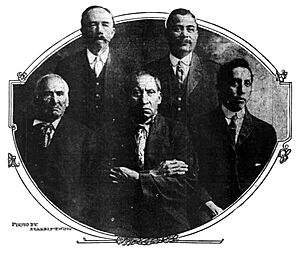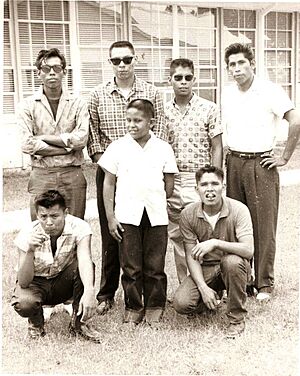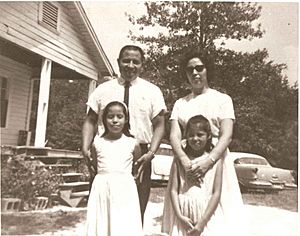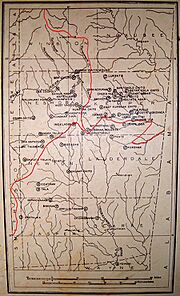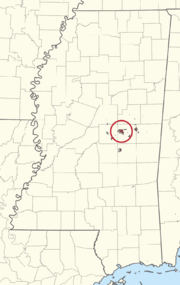Mississippi Band of Choctaw Indians facts for kids
Quick facts for kids
Mississippi Band of Choctaw Indians
|
||
|---|---|---|
|
Government Organization
|
||
|
||
| Established | April 20, 1945 (Indian Reorganization Act) | |
| Tribal Headquarters | Choctaw, Neshoba County, Mississippi | |
| Communities |
List
Bogue Chitto, Mississippi
Bogue Homa, Mississippi Conehatta, Mississippi Henning, Tennessee Pearl River, Mississippi Redwater, Mississippi Standing Pine, Mississippi Tucker, Mississippi |
|
| Population
(2021)
|
||
| • Total | 11,100 | |
| Religions | Roman Catholicism, Baptism (denomination), Methodism, Traditional beliefs | |
| Website | www.choctaw.org | |
The Mississippi Band of Choctaw Indians (Choctaw: Mississippi Chahta) is a Native American tribe. They are one of three federally recognized tribes of Choctaw people. This means the United States government officially recognizes them as a sovereign nation. They are the only Choctaw tribe located in the state of Mississippi.
The tribe was officially formed on April 20, 1945. This happened under a law called the Indian Reorganization Act of 1934. Their special land, called a reservation, covers parts of several counties in Mississippi. These include Neshoba, Leake, Newton, Scott, Jones, Attala, Kemper, and Winston counties. In 2008, the Mississippi Choctaw got back their important ancestral site, Nanih Waiya mounds and cave. They celebrate August 18 as a tribal holiday to remember getting this sacred site back. The other two Choctaw groups are the Choctaw Nation of Oklahoma and the Jena Band of Choctaw Indians in Louisiana.
Contents
- History of the Choctaw People
- Leaving Their Homeland: Indian Removal
- Civil War and Changes in America
- Speaking Up in Washington, D.C.
- Rebuilding the Tribe in the 1930s
- Growth and Recognition in the 1940s
- Challenges and Changes in the 1950s
- Civil Rights and Self-Determination in the 1960s
- Economic Growth in the 1970s
- Strong Leadership and New Businesses
- Gaming and Resorts in the 1980s-1990s
- The 21st Century: A Major Employer
- Return of Nanih Waiya
- Where the Choctaw Live
- Notable Choctaw People
History of the Choctaw People
Leaving Their Homeland: Indian Removal
The Choctaw people have a long history in what is now Mississippi. In the early 1800s, American settlers wanted their land for farming. President Andrew Jackson signed the Indian Removal Act in 1830. This law aimed to move Native American tribes from the Southeast.
The Choctaw leaders signed the Treaty of Dancing Rabbit Creek in 1831. This treaty meant they had to give up millions of acres of land. The U.S. government wanted the Choctaw to move far west of the Mississippi River. Many Choctaw left their homes in stages between 1831 and 1833. However, some Choctaw chose to stay in Mississippi. They continued to live in their ancient homeland. The nearly 5,000 Choctaw who stayed became citizens of Mississippi and the United States.
For many years, those who stayed faced hard times. White settlers often treated them unfairly. They faced legal problems, harassment, and bullying. One Choctaw person said in 1849 that their homes were destroyed. They were also personally hurt, with some of their best men dying.
Civil War and Changes in America
The Mississippi Choctaw also took part in the American Civil War. Many Choctaw men joined the 1st Choctaw Battalion. Later, some joined Spann's Independent Scouts. They fought until the war ended.
Life for the Choctaw got even harder after the Civil War. During the time known as Reconstruction, white leaders in Mississippi worked to bring back white supremacy. This meant they wanted white people to have all the power. They also tried to stop Black people from voting. In 1890, a new state constitution made it very hard for Black people to vote. Under new laws called Jim Crow laws, all people of color, including Choctaw, had to use separate facilities. This was called racial segregation.
Speaking Up in Washington, D.C.
By 1907, the Mississippi Choctaw population was very small. Many had been sent to Indian Territory (now Oklahoma). Only 1,253 members remained. In 1913, meetings were held to find a solution. Wesley Johnson was chosen as chief of a new council. This council represented Choctaw people in Mississippi, Alabama, and Louisiana.
The council decided to send delegates to Washington, D.C. They wanted to tell the government about the Choctaw's difficult situation. In January 1914, Chief Wesley Johnson and two delegates, Culbertson Davis and Emil John, traveled to Washington. They met with many important leaders, including President Woodrow Wilson. Culbertson Davis gave the President a special beaded Choctaw belt.
Their trip helped. In 1916, a law called the Indian Appropriations Act was passed. It set aside money to study the Choctaw's living conditions. A report was made in November 1916.
Hearings for Choctaw Needs
In March 1917, federal leaders held meetings in Union, Mississippi. About 100 Choctaw people attended. Important members of Congress were there. These meetings led to better access to health care, housing, and schools for the Choctaw.
However, progress slowed down due to major world events. World War I meant the government focused on the war. The Spanish flu pandemic also caused many deaths among the Choctaw.
Rebuilding the Tribe in the 1930s
During the Great Depression, the U.S. government started new programs to help people. A report in 1933 showed how difficult life was for the Mississippi Choctaw. Their population had fallen to 1,665 people. John Collier, who was in charge of Indian Affairs, used this report. He suggested that the Mississippi Choctaw should reorganize. This would allow them to form their own tribal government. It would also help them work directly with the federal government.
In 1934, President Franklin Roosevelt signed the Indian Reorganization Act of 1934. This law was very important for the survival of many tribes, including the Choctaw. Baxter York, Emmett York, and Joe Chitto worked hard to get the Choctaw recognized. They knew the tribe needed its own constitution. Some people worried about too much control from the Bureau of Indian Affairs (BIA). But eventually, the tribe adopted a constitution. Baxter and Emmett York became the first Tribal Council members. Joe Chitto was the first chairperson.
Growth and Recognition in the 1940s
With their new government, the tribe gained more support. In 1944, the government set aside 18,000 acres of land for the Mississippi Choctaw. This land became a federal Indian reservation. Eight communities were part of this reservation: Bogue Chitto, Bogue Homa, Conehatta, Crystal Ridge, Pearl River, Red Water, Tucker, and Standing Pine.
On April 20, 1945, the Mississippi Choctaw officially reorganized. They became the Mississippi Band of Choctaw Indians. The U.S. government recognized them as a sovereign nation. This gave them independence from the state government.
Challenges and Changes in the 1950s
In the 1950s, some U.S. government leaders wanted Native American tribes to become more like the rest of American society. They started a policy called "termination." This aimed to end the special status of some tribes. They also created programs to help Native Americans move to cities. The idea was to help them find jobs and new opportunities.
However, the Choctaw people still faced economic struggles. They dealt with prejudice, cultural isolation, and few jobs in their rural area. But with their new tribal government, they slowly took control. They began managing their own schools, health care facilities, legal systems, and social programs.
Civil Rights and Self-Determination in the 1960s
During the Civil rights movement (around 1965-1982), Native Americans renewed their pride in their heritage. They worked to celebrate their culture and gain their rights. U.S. Presidents like John F. Kennedy, Lyndon Johnson, and Richard Nixon stopped the "termination" policy. They supported tribes keeping their special relationship with the federal government.
President Johnson said in 1968, "We must affirm the right of the first Americans to remain Indians while exercising their rights as Americans." The Civil Rights Era brought big changes for the Choctaw. Their civil rights improved, just like those of African Americans. Before the Civil Rights Act of 1964, many jobs and public places were only for white people.
The Choctaw had been treated differently as people of color. They were often left out. One Choctaw woman remembered thinking a "white only" sign in a store meant she could only buy vanilla ice cream. This shows how a "third race" could be forgotten. The end of racial segregation meant the Choctaw could now use public places that were once only for white people. Around this time, states also started allowing gambling to raise money. Native American tribes began to see this as a way to create jobs and income on their reservations.
Economic Growth in the 1970s
In the 1970s, the Choctaw focused on building their community. Congress passed the Indian Self-Determination and Education Assistance Act of 1975. This law was a big step. It allowed tribes to manage more of their own education and social service programs. It also gave money to tribes to help them take on these responsibilities.
Strong Leadership and New Businesses
Phillip Martin was a U.S. Army veteran. After World War II, he returned to Neshoba County, Mississippi. He saw how poor his people were and decided to stay and help. A minister named Will D. Campbell also saw the poverty. He wrote about the "depressing sight of the Choctaws."
Phillip Martin became Chief, or Miko, of the Mississippi Band of Choctaw Indians in 1977. He served for 32 years, until 2007. Under his leadership, the tribal council worked on many economic projects. They wanted to bring businesses to the reservation. The tribe had people ready to work, natural resources, and no taxes. They attracted industries like automotive parts, greeting cards, and plastic molding.
Gaming and Resorts in the 1980s-1990s
In 1987, the Supreme Court of the United States made an important decision. It said that federally recognized tribes could run gaming (casino) facilities on their sovereign reservation land. States could not stop them. In 1988, the U.S. Congress passed the Indian Gaming Regulatory Act (IGRA). This law set rules for tribes to operate casinos. It also allowed them to make agreements with states, sometimes sharing a part of their earnings.
In 1992, Mississippi Governor Kirk Fordice gave permission for the Mississippi Band of Choctaw Indians to open casinos. As a result, the MBCI now runs one of the biggest casino resorts in the country. It is located in Choctaw, Mississippi. The Silver Star Casino opened in 1994. The Golden Moon Casino opened in 2002. Together, these casinos are known as the Pearl River Resort.
The 21st Century: A Major Employer
Today, the Mississippi Band of Choctaw Indians is one of the largest employers in Mississippi. In the early 2000s, they ran 19 businesses. They employed 7,800 people. This shows how much the tribe has grown and succeeded.
Return of Nanih Waiya
After almost 200 years, the Mississippi Band of Choctaw got back control of Nanih Waiya. Nanih Waiya is a special place with a large platform mound and other earthworks. These structures were built as early as 100 to 400 CE. The Choctaw people believe this site and a nearby cave are where their ancestors came from. For many years, the state of Mississippi protected it as a state park. But in 2006, Mississippi returned Nanih Waiya to the Choctaw tribe.
The official document was signed on August 18, 2008. Since then, the Choctaw have celebrated this day as a tribal holiday. They tell stories of their origin, share traditional foods, and perform special dances.
Where the Choctaw Live
Long ago, the Choctaw lived in many towns across Mississippi. These included Lukfata, Koweh Chito, and Oka Hullo. They were mostly in Neshoba and Kemper counties. The Choctaw would travel hundreds of miles to hunt in the winter. They would return in the spring to plant their gardens.
Today, the Mississippi Choctaw Indian Reservation has eight main communities:
- Bogue Chitto or "Bok Cito", Mississippi
- Bogue Homa
- Conehatta
- Crystal Ridge
- Henning, Tennessee
- Pearl River
- Red Water
- Tucker
- Standing Pine
These communities are located in parts of nine counties in Mississippi. Most of the land and people are in Neshoba County. The total land area of the reservation is about 32.5 square miles. In 2000, about 5,190 people lived there. The nine counties with reservation land are Neshoba, Newton, Leake, Kemper, Jones, Winston, Attala, Jackson, and Scott counties.
Notable Choctaw People
- Beasley Denson, tribal chief, 2007—2011
- Jeffrey Gibson, artist
- Phillip Martin, tribal chief, 1978—2007
- Powtawche Valerino, engineer



